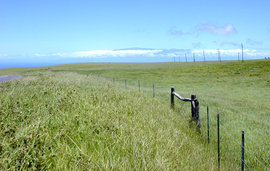Hawaii (island)
|
|
STS61A-50-57.jpg
The Island of Hawai‘i is one of the eight main islands that make up the state of Hawai‘i. It is said to have been named after Hawai‘iloa, a legendary Polynesian navigator to whom discovery of the Hawaiian Islands is attributed. The island is administered under the County of Hawai‘i.
It is estimated that as of the year 2003, the island had a resident population of 158,423 persons.
| Contents |
Geology and geography
The Island of Hawai‘i is built from five separate shield volcanoes that erupted somewhat sequentially, one overlapping the other. These are (from oldest to youngest): Kohala (extinct), Mauna Kea (dormant), Hualālai (dormant), Mauna Loa (active, partly within Hawai‘i Volcanoes National Park), and Kīlauea (very active; part of Hawai‘i Volcanoes National Park). Interpretation of geological evidence from exposures of old surfaces on the south and west flanks of Mauna Loa led to the proposal that two ancient volcanic shields (named Ninole and Kulani) were all but buried by the younger Mauna Loa (MacDonald and Abbott, 1970). Geologists now consider these "outcrops" to be part of the earlier building of Mauna Loa.
In greatest dimension, the Island is 93 miles (150 km) across and has a land area of 4,038 mile² (10,458 km²), representing more than half (~62% actually) of the total land area of the Hawaiian Islands. Traditionally, Hawai‘i is known as the Big Island because it is the largest of the Hawaiian Islands and some confusion between Hawai‘i Island and Hawai‘i State can be avoided.
Because Mauna Loa and Kīlauea are active volcanoes, the island of Hawai‘i is still growing. Between January 1983 and September 2002, 2.2 km² (543 ac) of land were added to the island by lava flows from Kīlauea volcano extending the coastline seaward. Several towns have been destroyed by Kīlauea lava flows in modern times: Kapoho (1960), Kalapana (1990), and Kaimū (1990).
Hawai‘i is the southernmost island in the Hawaiian archipelago. The nearest landfall to the south would be in the Line Islands. To the north is the island of Maui, where Haleakalā (East Maui Volcano) is visible across the Alenuihaha Channel (see photo at left).
18 miles (29 kilometers) off Hawai‘i Island's southeast coast is the undersea volcano known as Lo‘ihi. Lo‘ihi is an actively erupting seamount that lies 3,200 feet (975 meters) below the surface of the ocean. It is thought that continued volcanic activity from Lo‘ihi will cause the volcano to eventually breach sea level and later attach at the surface onto Kīlauea, adding even more land to Hawai‘i's surface area. This "event" is presently predicted for a date several tens of thousands of years in the future.
Akakafalls1.jpg
Economy
Sugarcane was the backbone of Hawai‘i Island's economy for more than a century. In the mid-twentieth century, sugar plantations began to downsize and by 1996, the last sugar cane plantation had closed down.
Today, most of Hawai‘i Island's economy is based on tourism, centered primarily on the leeward (kona) or western coast of the island in the North Kona and South Kohala districts. However, diversified agriculture is a growing sector of the economy of the island. Macadamia nuts, papaya, flowers, tropical and temperate vegetables, and coffee are all important crops. In fact, because of Hawai‘i Island's reputation for growing beautiful orchids, the island has the nickname "The Orchid Isle." Cattle ranching is also important.
Important towns and cities
Hilo, with a population of 40,759 as of the 2000 Census, is the largest city on Hawai‘i Island and the second largest city in the state. Hilo is also the county seat for Hawai‘i County. Hilo is where the University of Hawaii, Hilo Campus is located.
Kailua-Kona is the second largest city on Hawai‘i Island, and is the gateway to most of the Big Island's hotels.
Places of interest
- Hawaii Volcanoes National Park; comprising the active volcanoes Kīlauea and Mauna Loa
- Pu‘uhonua O Hōnaunau National Historical Park
- Onizuka Space Center; museum dedicated to the memory of Challenger astronaut Ellison Onizuka
- Hulihe‘e Palace; royal palace from Hawai‘i's monarchy days in Kailua-Kona
- ‘Akaka Falls; tallest waterfall on the Island.
External link
- Photos of the Island of Hawaii - Terra Galleria (http://www.terragalleria.com/pacific/hawaii-big-island)
Sources
- MacDonald, G. A., and A. T. Abbott. 1970. Volcanoes in the Sea. Univ. of Hawai‘i Press, Honolulu. 441 pages.
| Missing image Hawaii_state_flag.png Flag of | State of Template:Unicode Cities | Geography | History | Language | Landmarks |
|---|---|
| State capital: | Honolulu |
| Principal towns: | Hilo | Honolulu | Kahului | Kailua-Kona | Template:Unicode |
| Islands: | Template:Unicode | Template:Unicode | Template:Unicode | Template:Unicode | Maui | Template:Unicode | Template:Unicode | Northwestern Hawaiian Islands | Template:Unicode |
| Counties: | Template:Unicode | Honolulu | Kalawao | Template:Unicode | Maui |
de:Hawaii (Insel) et:Hawaii saar nl:Hawai'i (eiland) ja:ハワイ島 simple:Hawaii (island)

